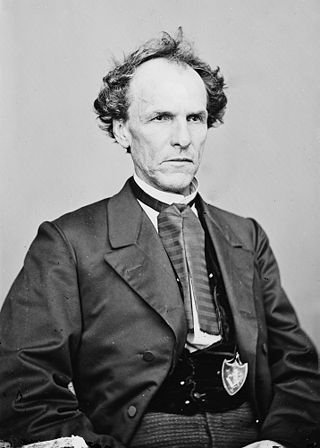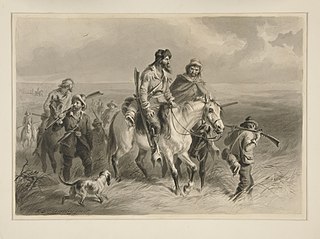Related Research Articles
The U.S. state of Kansas, located on the eastern edge of the Great Plains, was the home of nomadic Native American tribes who hunted the vast herds of bison. In around 1450 AD, the Wichita People founded the great city of Etzanoa. The city of Etzanoa was abandoned in around 1700 AD. The region was explored by Spanish conquistadores in the 16th century. It was later explored by French fur trappers who traded with the Native Americans. Most of Kansas became permanently part of the United States in the Louisiana Purchase of 1803. When the area was opened to settlement by the Kansas–Nebraska Act of 1854 it became a battlefield that helped cause the American Civil War. Settlers from North and South came in order to vote slavery down or up. The free state element prevailed.

Bleeding Kansas, Bloody Kansas, or the Border War was a series of violent civil confrontations in Kansas Territory, and to a lesser extent in western Missouri, between 1854 and 1859. It emerged from a political and ideological debate over the legality of slavery in the proposed state of Kansas.

The Territory of Kansas was an organized incorporated territory of the United States that existed from May 30, 1854, until January 29, 1861, when the eastern portion of the territory was admitted to the Union as the free state of Kansas.

The Lecompton Constitution (1858) was the second of four proposed constitutions for the state of Kansas. Named for the city of Lecompton where it was drafted, it was strongly pro-slavery. It never went into effect.

In the United States before 1865, a slave state was a state in which slavery and the internal or domestic slave trade were legal, while a free state was one in which they were prohibited. Between 1812 and 1850, it was considered by the slave states to be politically imperative that the number of free states not exceed the number of slave states, so new states were admitted in slave–free pairs. There were, nonetheless, some slaves in most free states up to the 1840 census, and the Fugitive Slave Clause of the U.S. Constitution, as implemented by the Fugitive Slave Act of 1793 and the Fugitive Slave Act of 1850, provided that a slave did not become free by entering a free state and must be returned to his or her owner.

The Provisional Government of the Territory of Jefferson was an extralegal and unrecognized United States territory that existed in the Pike's Peak mining region from October 24, 1859, until it yielded to the new Territory of Colorado on June 6, 1861. The Jefferson Territory, named for Founding Father and third United States president Thomas Jefferson, included land officially part of the Kansas Territory, the Nebraska Territory, the New Mexico Territory, the Utah Territory, and the Washington Territory, but the region was remote from the governments of those five territories.

Brigadier-General James Henry Lane was an American politician and military officer who was a leader of the Jayhawkers in the Bleeding Kansas period that immediately preceded the American Civil War. During the war itself, Lane served in the United States Senate and as a general officer in the Union Army. Although reelected as a Senator in 1865, Lane died by suicide the next year.

Border ruffians were proslavery raiders who crossed into the Kansas Territory from Missouri during the mid-19th century to help ensure the territory entered the United States as a slave state. Their activities formed a major part of a series of violent civil confrontations known as "Bleeding Kansas", which peaked from 1854 to 1858. Crimes committed by border ruffians included electoral fraud, intimidation, assault, property damage and murder; many border ruffians took pride in their reputation as criminals. After the outbreak of the American Civil War in 1861, many border ruffians fought on the side of the Confederate States of America as irregular bushwhackers.

The Topeka Constitutional Convention met from October 23 to November 11, 1855 in Topeka, Kansas Territory, in a building afterwards called Constitution Hall. It drafted the Topeka Constitution, which banned slavery in Kansas, though it would also have prevented free blacks from living in Kansas. The convention was organized by Free-Staters to counter the pro-slavery Territorial Legislature elected March 5, 1855, in polling tainted significantly by electoral fraud and the intimidation of Free State voters.

The 1858–59 United States House of Representatives elections were held on various dates in various states between June 7, 1858, and December 1, 1859. Each state set its own date for its elections to the House of Representatives. 238 representatives were elected in the new state of Oregon, the pending new state of Kansas, and the other 32 states before the first session of the 36th United States Congress convened on December 5, 1859. They were held during President James Buchanan's term.

The Kansas Legislature is the state legislature of the U.S. state of Kansas. It is a bicameral assembly, composed of the lower Kansas House of Representatives, with 125 state representatives, and the upper Kansas Senate, with 40 state senators. Representatives are elected for two-year terms, senators for four-year terms.

Free-Staters was the name given to settlers in Kansas Territory during the "Bleeding Kansas" period in the 1850s who opposed the expansion of slavery. The name derives from the term "free state", that is, a U.S. state without slavery. Many of the "free-staters" joined the Jayhawkers in their fight against slavery and to make Kansas a free state.

At the outbreak of the American Civil War in April 1861, Kansas was the newest U.S. state, admitted just months earlier in January. The state had formally rejected slavery by popular vote and vowed to fight on the side of the Union, though ideological divisions with neighboring Missouri, a slave state, had led to violent conflict in previous years and persisted for the duration of the war.

The Missouri Compromise was a federal legislation of the United States that balanced desires of northern states to prevent expansion of slavery in the country with those of southern states to expand it. It admitted Missouri as a slave state and Maine as a free state and declared a policy of prohibiting slavery in the remaining Louisiana Purchase lands north of the 36°30′ parallel. The 16th United States Congress passed the legislation on March 3, 1820, and President James Monroe signed it on March 6, 1820.
The timeline of Kansas details past events that happened in what is present day Kansas. Located on the eastern edge of the Great Plains, the U.S. state of Kansas was the home of sedentary agrarian and hunter-gatherer Native American societies, many of whom hunted American bison. The region first appears in western history in the 16th century at the time of the Spanish conquest of the Aztec Empire, when Spanish conquistadors explored the unknown land now known as Kansas. It was later explored by French fur trappers who traded with the Native Americans. It became part of the United States in the Louisiana Purchase of 1803. In the 19th century, the first American explorers designated the area as the "Great American Desert."

Quindaro Townsite is a former settlement, then ghost town, and now an archaeological district. It is around North 27th Street and the Missouri Pacific Railroad tracks in Kansas City, Kansas. It was placed on the National Register of Historic Places on May 22, 2002.

The presidency of James Buchanan began on March 4, 1857, when James Buchanan was inaugurated as 15th president of the United States, and ended on March 4, 1861. Buchanan, a Democrat from Pennsylvania, took office as the 15th United States president after defeating former President Millard Fillmore of the American Party, and John C. Frémont of the Republican Party in the 1856 presidential election.

The 1859 California gubernatorial election was held on September 7, 1859 to elect the governor of California.

There is an African-American community in Kansas, including in Kansas City, Kansas. Nicodemus, Kansas is the oldest surviving town west of the Mississippi River settled solely by African Americans.
Under U.S. law, a state requires a constitution. A main order of business for Territorial Kansas was the creation of a constitution, under which Kansas would become a state. Whether it would be a slave state or a free state, allowing or prohibiting slavery, was a national issue, because it would affect voting in the polarized U.S. Senate. Because of tensions over slavery, four quite different constitutions of Kansas were drafted.
References
- ↑ Pillsbury, Parker (October 8, 1859). "Letter from Parker Pillsbury". Anti-Slavery Bugle (Lisbon, Ohio). p. 2 – via newspapers.com.
- ↑ "Report" (PDF). kshs.org. Retrieved 13 September 2023.
- 1 2 "Wyandotte County, Kansas History - Ch. XIV". www.ksgenweb.org. Retrieved 2021-08-31.
- 1 2 3 "Kansas Constitutions." KSHS.org. Kansas Historical Society.
- 1 2 3 Buescher, John. "With or Without Slavery." TeachingHistory.org. Roy Rosenzweig Center for History and New Media at George Mason University. Retrieved 2 September 2011.
- ↑ Few Republicans and All Democrats favored Exclusion Archived June 8, 2013, at the Wayback Machine
- ↑ "Clarina Nichols - Kansapedia - Kansas Historical Society". www.kshs.org. Retrieved 2021-08-31.
- ↑ "Wyandotte Constitution - Kansapedia - Kansas Historical Society". www.kshs.org. Retrieved 2021-08-31.
- ↑ "Wyandotte Constitution | Civil War on the Western Border: The Missouri-Kansas Conflict, 1854-1865". civilwaronthewesternborder.org. Retrieved 2021-08-31.
- ↑ Preamble Accessed 13 October 2013